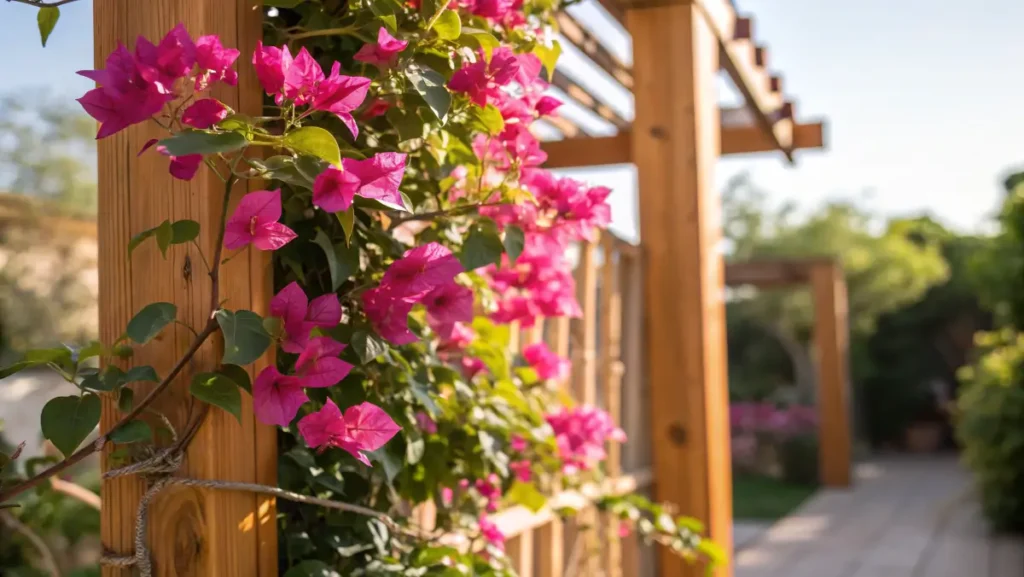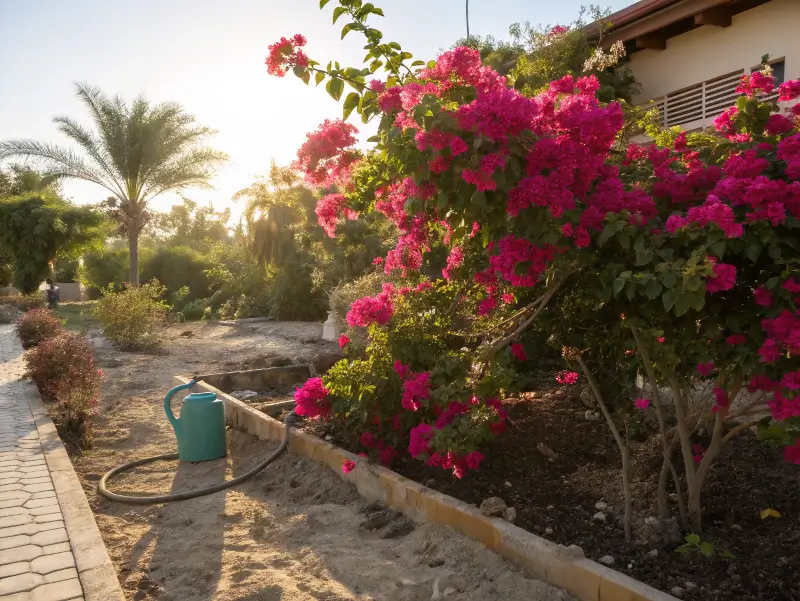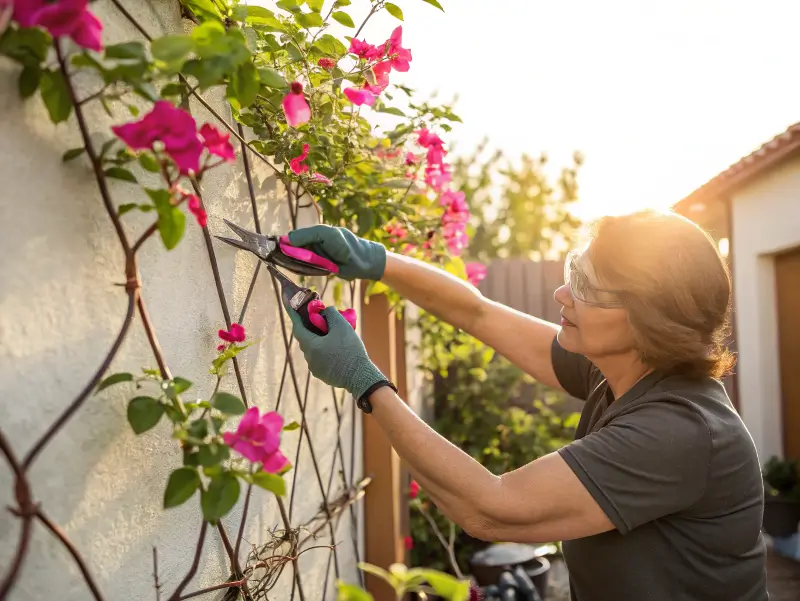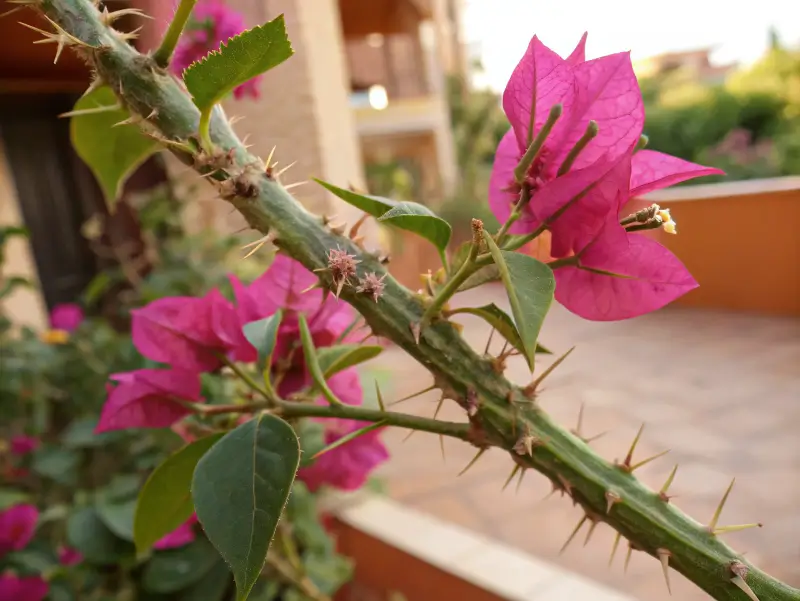
I’m a total garden geek who can’t wait to share my love of the bougainvillea plant. These bright blooms are turning heads across America as folks freshen up their yards for warmer months. I’ll discuss caring for these stunning vines, choosing the right spot, and keeping them healthy year-round. You’ll get tips for pest control, winter care, and clever shortcuts, with my personal stories tossed in for good measure today.
Table of Contents
Introduction to the bougainvillea plant
Origins and Historical Background
I’ve got a small confession: the bougainvillea plant stole my heart when I first saw its vivid floral bracts spilling over a neighbor’s fence. Out of curiosity, I learned these flashy blooms came from South America but quickly spread to warmer climates worldwide. Some folks call them the “Paper Flower” because of those thin, crinkly bracts—personally, I think they look like tissue-paper confetti at a tropical party.
- Native to South America.
- Known as “Paper Flower.”
- Loved for bright, colorful bracts.
Today, many gardeners and hobbyists plant bougainvillea plants for their exotic appeal. They add a tropical vine flair to walls, fences, or even containers. Honestly, the day I planted my first one felt like adding a mini vacation spot to my yard.
Popularity and Visual Appeal
So, why does everyone seem to rave about the bougainvillea plant?
- Low-maintenance once established.
- Contributes a “wow” factor to any garden.
- Pairs well with other ornamental plants.
The bright clusters can turn a bland fence into a blooming masterpiece. I always say these vines embody an easygoing vibe—like a permanent summer vacation right in your backyard.
Understanding Bougainvillea Varieties
Top Species and Hybrids
I’ve bumped into quite a few bougainvillea plants over the years. Some of my favorites include:
- ‘Barbara Karst’: Fiery-red bracts that pop in bright sunlight.
- ‘California Gold’: Golden blooms that shimmer at midday.
- Purple Varieties: Rich purples which create a striking contrast.
Each type has something special. I once visited a friend who had two-tone hybrids—pink and white on the same vine! If you’re itching for variety, check garden centers for unique hybrids that bring an eye-catching blend of colors.
Choosing What Suits Your Space
Picking a bougainvillea plant can feel like a mini style session for your yard. Some folks want climbing shrubs, while others want something shorter. I suggest you think about:
- Space: Tall fences or compact corners?
- Bloom Color: Bold reds, lovely pinks, chilling purples, or sunny yellows?
- Growth Habit: Climbers or bushy forms?
Honestly, I lean toward climbing varieties whenever I want to hide an ugly wall or fence. If you prefer a tidy look, there are dwarf strains that act more like a shrub-like growth. One neighbor has an entire row in planters, giving a pop of color along her walkway—a total showstopper.
Ideal Growing Conditions for bougainvillea plant

Soil Requirements and Drainage
A bougainvillea plant loves soil that drains well. I made the mistake of putting my first cutting into heavy, sticky soil, and it sulked for weeks. Lesson learned:
- Mix in coarse sand or perlite if your dirt is dense.
- Keep the soil slightly acidic to neutral (somewhere in the 5.5 to 6.5 pH range).
- Avoid waterlogged areas that lead to root rot.
If you’re planting in a container, use a pot with ample drainage holes. I usually toss in some pebbles at the bottom to help water flow.
Sunlight and Climate Needs
Let’s face it—these guys adore sun. The bougainvillea plant craves at least six hours of direct light daily. Think:
- Full sun exposure for maximum blooms.
- Partial afternoon shade only if your climate is scorching.
- Protection from chilly or frosty weather.
If you live in a cooler state, it might be wise to plant them adjacent to a south-facing wall that holds some heat. I did that, and it saved my vines during some surprise cold fronts last year.
Watering and Moisture Control
Meanwhile, watering can be a balancing act. I’ve learned to water deeply but infrequently, allowing the top few inches of soil to dry between soaks. Overwatering leads to soggy soil, and a bougainvillea plant does not appreciate wet feet. During hot summers, you might need to water about twice a week, but slow it down as the weather cools.
If you see leaves turning yellow, scale back your watering schedule. Drought-tolerant plant or not, it still needs consistent but moderate moisture. Keep an eye on your local forecast—monsoon rains or heavy downpours mean you can skip your usual watering day.
Planting bougainvillea plant in Pots vs. Ground
Container Gardening with Bougainvillea
Some folks say bougainvillea plants actually bloom better when their roots are slightly cramped. Containers allow you to:
- Move plants around to catch prime sunlight.
- Bring them indoors if winter bites too hard.
- Simplify watering routines by using well-draining potting mix.
I love container gardening because it’s perfect for decks or balconies. The main caution? If your pot is too big, you risk soggy soil—so pick a moderate size with good water flow. I also find that rooting them in containers makes them a colorful focal point for smaller yards.
Establishing Bougainvillea in the Landscape
On the other hand, planting a bougainvillea plant in the ground works wonderfully if you have space. Before you dig:
- Make sure soil drains properly.
- Give each plant enough room to sprawl.
- Add some compost for nutrient boosts.
I planted mine near a picket fence, and now it climbs over the top, forming a naturally colorful hedge. Just remember, bougainvillea plants can get tall and wide, so they might need pruning to avoid overwhelming neighboring plants or walkways.
Pruning and Training Bougainvillea for Optimal Growth

Seasonal Pruning Techniques
Let’s talk snipping. If you want your bougainvillea plant to keep producing those bombshell blooms, moderate pruning is key. Generally, I:
- Prune after the main flowering cycle.
- Snip dead or damaged branches first.
- Trim lightly to maintain shape.
Overdoing it can leave you with fewer bracts—definitely not the goal. From my experience, heading into late fall with a fresh chop can interfere with next season’s flush, so I wait until the bloom show starts to fade. If I see straggly growth in early summer, I do a light trim to keep the shape neat.
Training Bougainvillea as a Climber or Bush
Check it out: the bougainvillea plant can fill multiple roles in your garden. You can train it up a trellis, letting it become a vigorous ornamental climber. Or you can pinch tips and shape it into a compact bush. Either way, keep these tips in mind:
- For Climbing: Tie new stems gently onto a trellis or fence with soft plant ties.
- For Bush Forms: Prune branch tips to encourage side shoots.
I once turned a small cutting into a mini privacy hedge on my patio with consistent pinching. My friend, though, let hers climb an archway, creating a dramatic entry zone. Both look awesome, so it’s all about your preference.
Maintenance and Safety Tips
Remember, these vines often come with thorny stems. When you’re messing with them, wear gloves, or you’ll be covered in scratches—speaking from experience. Always carry pruning shears with a clean blade to avoid fungus or bacterial issues. Once done, gather and discard cuttings properly, so your yard stays tidy. Keep in mind, a healthy bougainvillea plant can handle moderate snips without fuss.
Fertilizing and Feeding bougainvillea plant
Essential Nutrients for Vibrant Bracts
Feeding your bougainvillea plant the right stuff is a game-changer. If you add a balanced fertilizer with slightly less nitrogen, you’ll enjoy maximum color. Fertilizers labeled 5-5-5 or 10-10-10, with an emphasis on phosphorus and potassium, are great. Why? Because too much nitrogen leads to more leaves instead of bright bracts.
- Feed every 4–6 weeks in spring and summer.
- Cut back feeding when cooler weather sets in.
- Avoid over-fertilizing, which can cause salt buildup.
Organic vs. Synthetic Fertilizers
I lean into organic methods whenever possible. Compost, well-rotted manure, and fish emulsion all add a gentle nutrient boost. If you prefer synthetic options, just read labels carefully. I’ve learned that “slow-release” is typically safer, minimizing the risk of burning your vine. And yes, you can switch between organic and synthetic if you want. The bougainvillea plant forgives as long as you don’t overdo it. A monthly feeding schedule might be enough, depending on your soil richness.
Common Pests, Diseases, and Downsides of bougainvillea plant

Identifying and Treating Infestations
Even though the bougainvillea plant is tough, pests like aphids, spider mites, and mealybugs can sneak in. Look for:
- Sticky residue on leaves (sign of aphids).
- Webbing near leaf joints (spider mites).
- White cottony masses (mealybugs).
A strong water spray can knock off tiny pests. If that fails, try insecticidal soap or neem oil. Also, keep your garden tidy and weed-free. That approach helps prevent unwanted bugs from settling in.
Potential Drawbacks of Growing Bougainvillea
I love bougainvillea plants, but they’re not perfect. For one, thorny stems can be a bit painful if you brush against them. Also, they’re sensitive to cold snaps, so folks living in long-winter zones must bring them indoors or protect them. And yes, these vines can sprawl aggressively, so keep pruning in mind to avoid an overgrown jungle. If you manage these issues, you’ll have a popping display of color for months.
Overwintering and Seasonal Care
Protecting Bougainvillea in Cooler Climates
When the temps dip, the bougainvillea plant can suffer. If you’re dealing with frosty nights, consider:
- Containers: Move potted vines indoors or to a warmer garage.
- Frost Cloth: Cover in-ground vines for extra warmth.
- Water Adjustments: Reduce watering to prevent root rot in cold, damp conditions.
I remember a rough January when I had to bundle my garden queen in bedsheets. It felt a bit silly, but it saved her from freezing.
Reintroducing Bougainvillea After Dormancy
When spring rolls around, it’s time to move your bougainvillea plant back outside. However, avoid shocking it with sudden temperature changes. Gradually reintroduce it to stronger sunlight:
- Place the pot in partial sun for a couple of days.
- Increase sun exposure over a week or two.
- Give a light fertilizer dose to jumpstart growth.
Trust me, this slow transition pays off. If the weather looks stable, you can permanently station your bougainvillea outdoors. Keep your eyes peeled for new buds; it’s a wonderful feeling seeing them pop back after a winter break.
Landscaping Ideas and Decorative Uses
Stunning Bougainvillea Displays
I’ve seen some jaw-dropping setups where the bougainvillea plant drapes over fences or arches, forming a rainbow of color. Other folks create living privacy walls by letting multiple bougainvillea plants grow side by side. If you’re short on space, a single vine in a large clay pot still looks stunning against a plain wall.
Creative Color Combinations
Pair your bougainvillea plant with other bright tropical wonders. For instance, a Night Blooming Jasmine Plant has subtle white blooms that glow at dusk, while plumbago or lantana can add even more vividness. Mixing colors gives your yard a playful, tropical vibe.
Frequently Asked Questions About bougainvillea plant
What is the Downside of Bougainvillea?
The biggest downside might be dealing with thorns. If you’ve ever worn shorts while pruning a mature bougainvillea plant, you understand the painful reality! Also, it can grow aggressively in warm climates, so you’ll want to maintain control with regular snips.
Do Bougainvillea Grow Better in Pots or Ground?
They do fine in both. Pots help if you live in a cooler place since you can bring them inside. The ground allows roots to spread, leading to bigger growth. Frankly, whichever suits your space is the right choice.
Is Bougainvillea a Climber or Bush?
It can be either! Train a bougainvillea plant to climb a trellis or shape it into a bush by pinching off tips. The versatility makes it an easy option for various yards.
Do Bougainvilleas Come Back Every Year?
Yes, in warmer regions, they’re evergreen. In cooler spots, they might go dormant, but they can bounce back if protected from deep frost and cared for properly.
Bonus Tips and Wrap-Up
I’ve got some shortcuts up my sleeve, guys. If you’re short on time:
- Mulch around the base to lock in moisture.
- Set a phone reminder for monthly feedings in late spring through early fall.
- Snip off spent bracts to encourage fresh blooms.
A buddy of mine says her bougainvillea plant stays happiest when she cuts back on watering during cooler months, letting it rest. When it warms up, she gradually gives it more water, and boom—gorgeous bracts everywhere come summer. You might find a similar rhythm once you see how your local weather behaves.
If you want further climate guidelines for different states, you could check the USDA Plant Hardiness Zones for general temperature ranges and frost dates. That resource helps me figure out the best times to shuffle my container babies indoors. Another garden companion that loves warm conditions is the Black Dahlia Flower, which can add a dramatic look next to the bright bracts of your vines.
If you’re super into fragrance, a Night Blooming Jasmine Plant might pair nicely with your bougainvillea plants, offering sweet aromas when the sun dips. Combining color and scent truly makes a magical backyard scene.
Remember, the bougainvillea plant is not perfect—it has thorns, and you might wrestle pests occasionally. Yet the payoff of those bold, exuberant blooms is totally worth it (in my humble opinion). It’s like having a splash of the tropics right at home. I hope this super-detailed breakdown helps you feel ready to add a bougainvillea plant or two to your garden. Enjoy the color, the vibe, and maybe a small scratch here or there—but trust me, you’ll be smiling every time those bracts pop.
